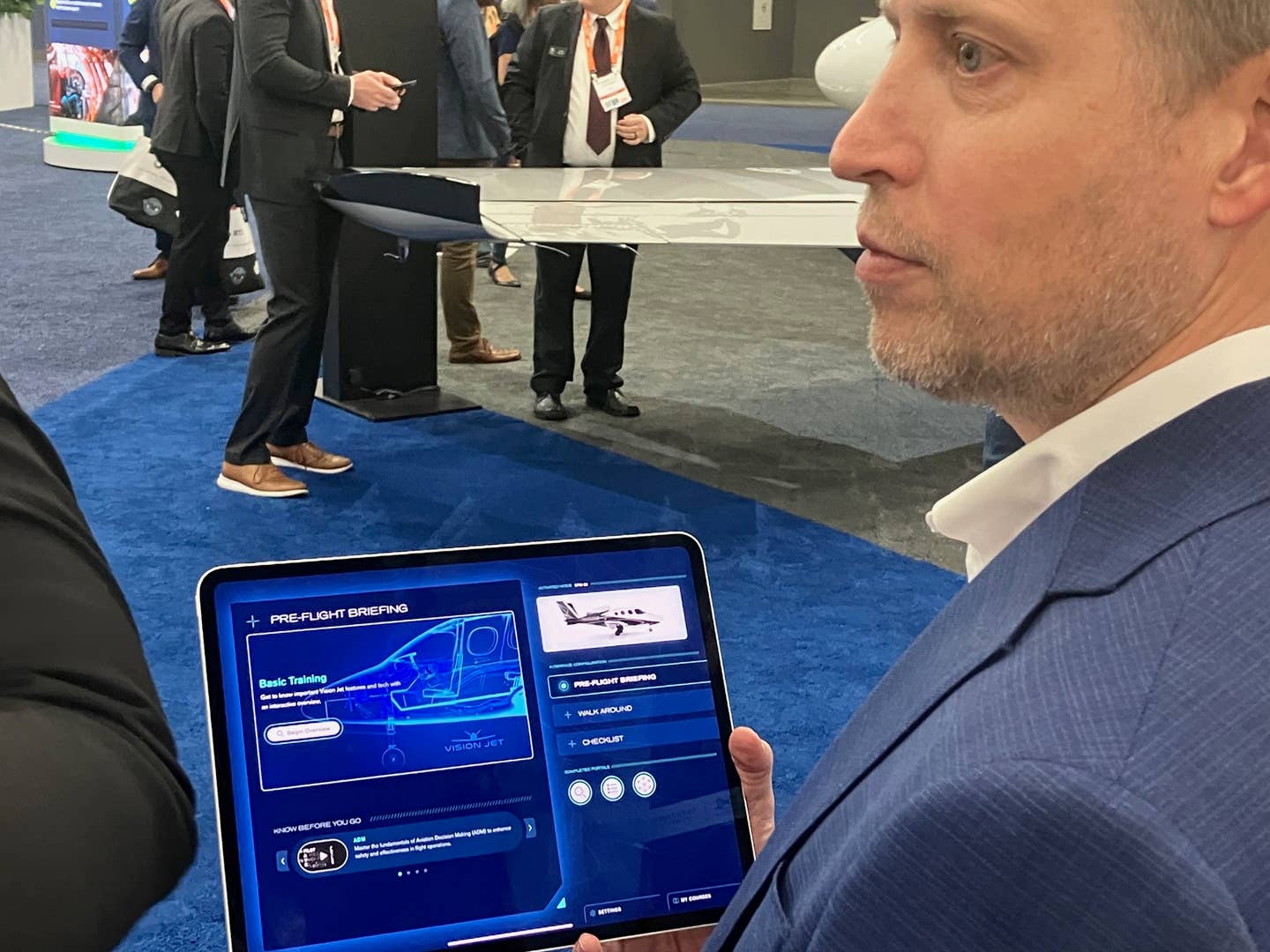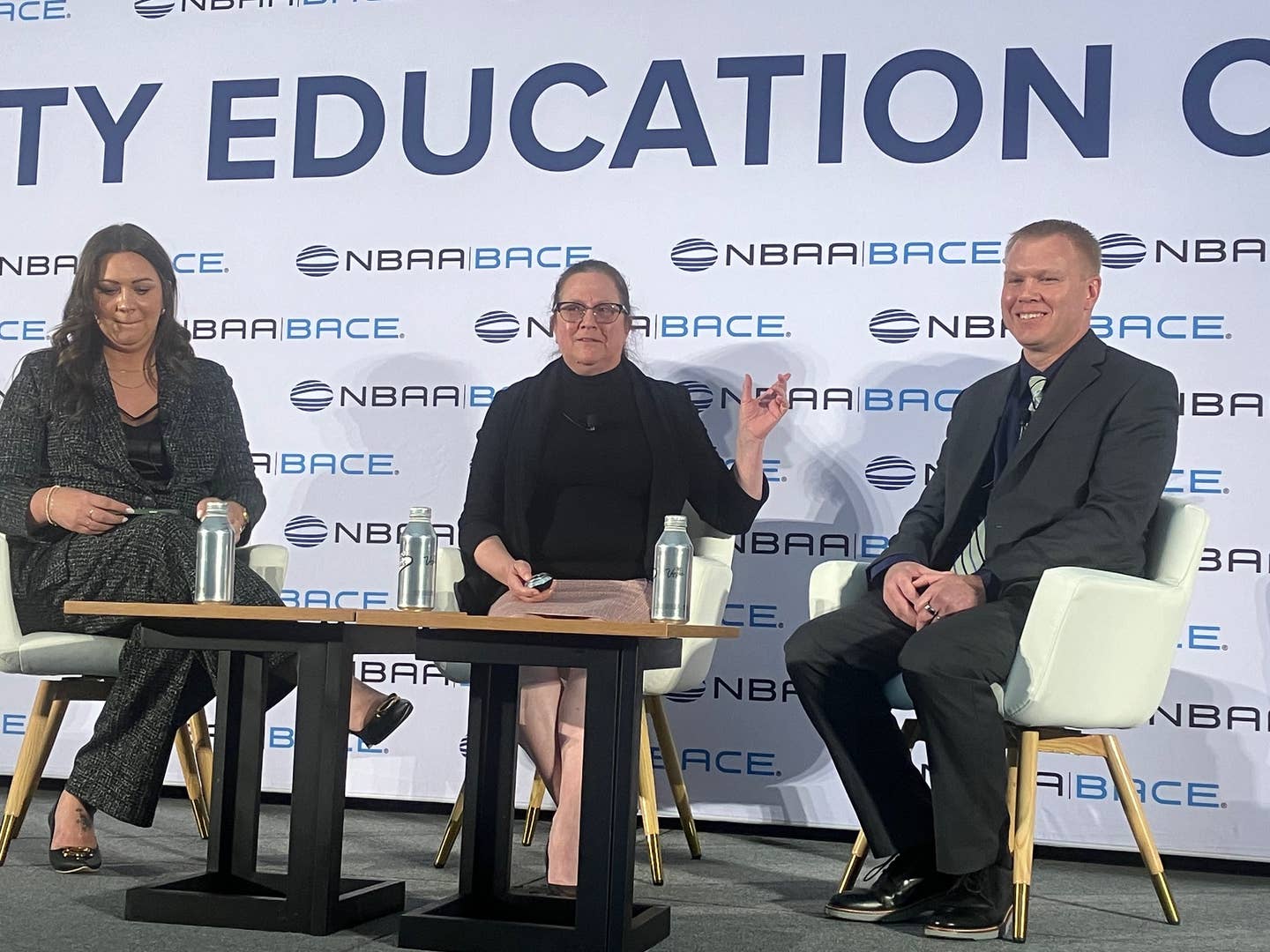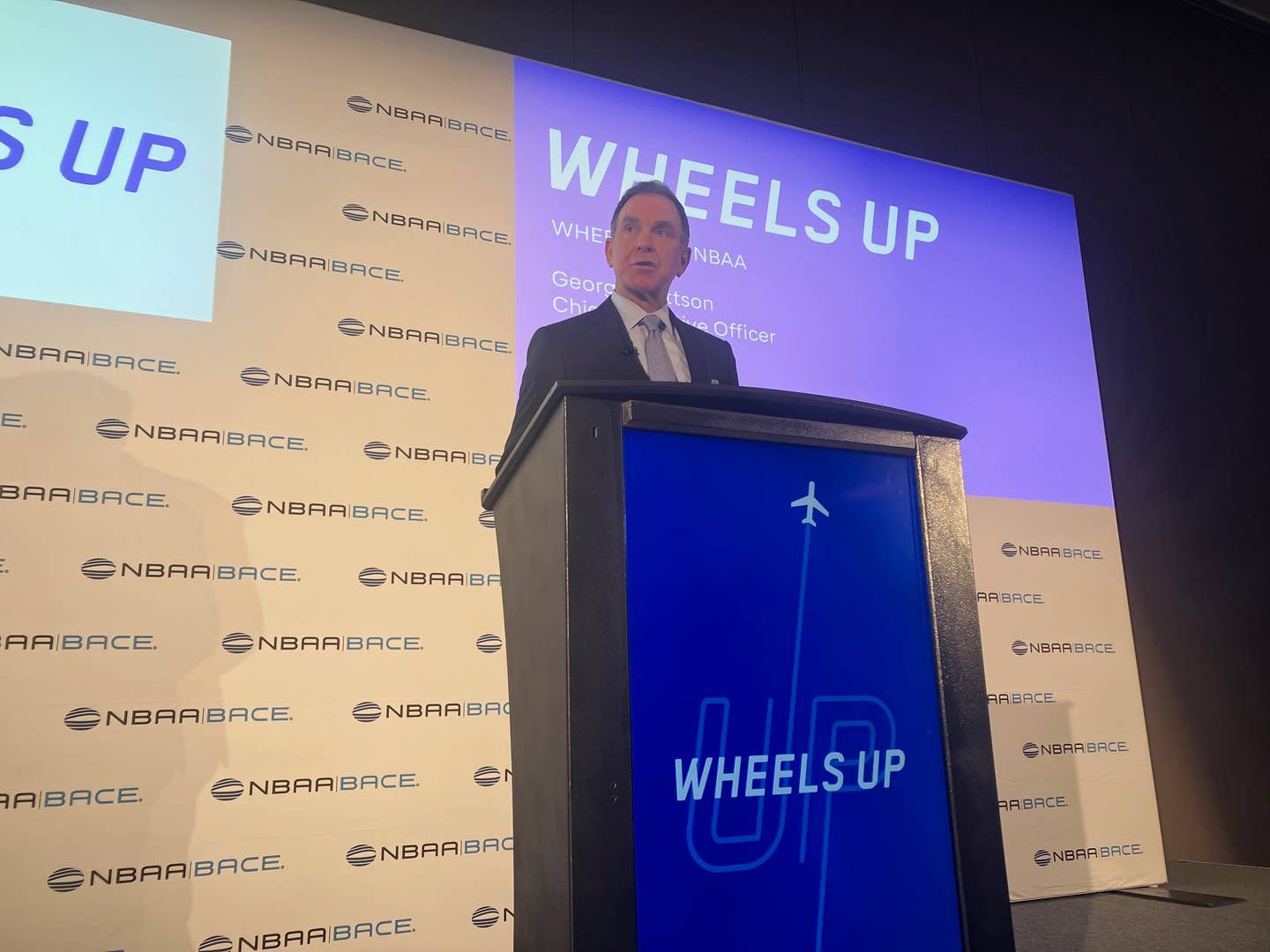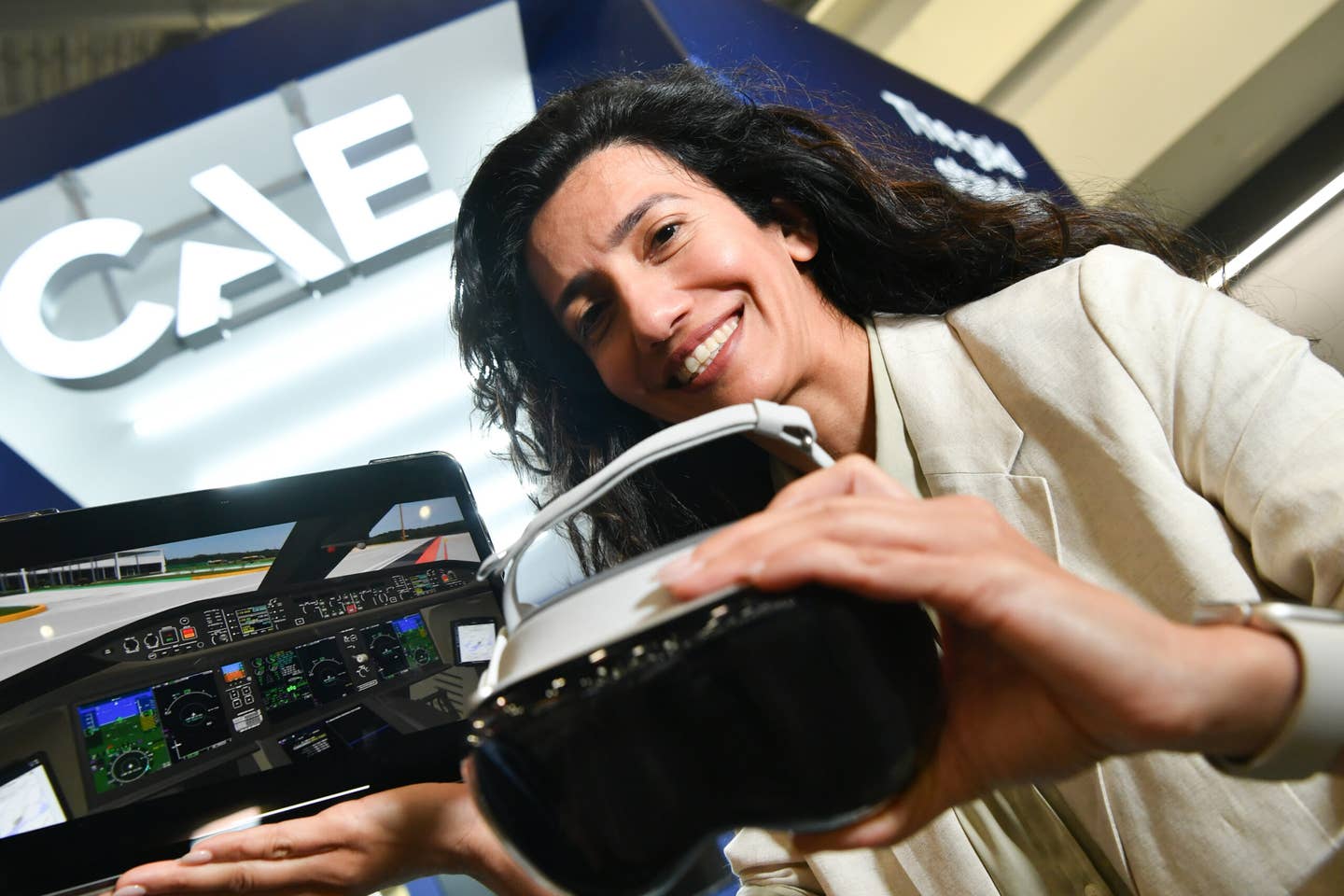Sun ‘N Fun 2001: The Week That Was
Top contender for most-talked-about topic at this year’s Sun ‘n Fun would have to be the FAA’s Sport Pilot proposal. Among those keeping a sharp eye on the proposal’s possible impact are light-engine manufacturers, who have been putting powerplants in ultralights and light experimentals for more than 15 years. The truth is that good (reliable) four-stroke engines, putting out anywhere from 45-120 HP are available now, from a variety of manufacturers and for them, Sport Pilot may prove to be a popularity contest they can’t afford to lose. AVweb’s Glenn Pew examines that story in the third and final installment of our Special Report: Sun ‘n Fun 2001. You’ll also find about New Piper’s plans for its future, Formula One air racing coming to south Florida this fall, ride along with two AVweb editors as they discover new ways to fly, and much, much more.
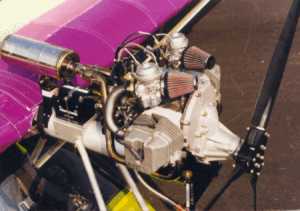
Sport Pilot Aircraft & Powerplants
'New' Engines Set To Take The Stage...
The truth is, you don't need a whole lot of horsepower to match the limits set forth in the proposed Sport Pilot regulations: 115 knots maximum speed, no more than two seats or 1,232 lbs. gross, etc... It follows that when you think about possible powerplants for the possible next generation of aircraft, you may not think of Textron or Teledyne. After nearly a decade of economic growth and several years of record general aircraft sales, the engine manufacturers that we're familiar with, themselves, aren't all that familiar with a demand for less horsepower from the American market. Now, the Sport Pilot regs may be pursuing just that. At the same time, you can be sure that at least a handful of small engine manufacturers are eager to steal the spotlight and specialize in Sport Pilot aircraft powerplant production - and a number of them already have a good deal of experience at it, including Rotax, Jabiru, LOM/Moravia and HKS.
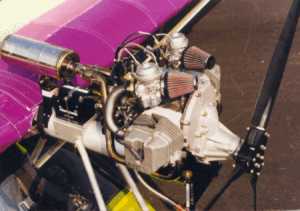 The most popular light engine manufacturers have been putting powerplants in ultralights and light experimentals for more than 15 years (corresponding with the introduction of FAR Part 103 for ultralights) and with Sport Pilot regulations looming, those powerplants, too, are the interests of those manufacturers. The truth is that good (reliable) four-stroke engines, putting out anywhere from 56-120 HP are available now, from a variety of manufacturers and for them, Sport Pilot may prove to be a popularity contest they can't afford to lose. On the eve of the battle, those manufacturers understand that they have as much to gain from the new regulations as pilots do and some of them are already thinking of ways to expand their markets. One interesting side effect is that all of us could still benefit from the battle even before it's formally begun.
The most popular light engine manufacturers have been putting powerplants in ultralights and light experimentals for more than 15 years (corresponding with the introduction of FAR Part 103 for ultralights) and with Sport Pilot regulations looming, those powerplants, too, are the interests of those manufacturers. The truth is that good (reliable) four-stroke engines, putting out anywhere from 56-120 HP are available now, from a variety of manufacturers and for them, Sport Pilot may prove to be a popularity contest they can't afford to lose. On the eve of the battle, those manufacturers understand that they have as much to gain from the new regulations as pilots do and some of them are already thinking of ways to expand their markets. One interesting side effect is that all of us could still benefit from the battle even before it's formally begun.
...For A Battle Of History Vs. The Future...
Rotax has been producing two-stroke engines for the aircraft market almost since there have been aircraft that would legally accept them and they are not eager to lose ground to younger upstarts. An early problem for Rotax may be that some of the flying public still remembers the Rotax as the noisy and tempermental two-stroke snowmobile-type engine that you start manually, not unlike a lawn mower. After all, that is the Rotax's history simply by nature of their longevity in the business. For Rotax, the marketing problem is not proof of brand, but proof that they've evolved to provide a product that the majority of pilots will accept - namely, a reliable four-stroke engine - and they have. The Diamond Katana was originally introduced to the market behind a Rotax engine and, though it was a great leap forward in establishing acceptance in the general aviation market, the Katana is now offered with a Continental engine. That change alone suggests - true or otherwise - that Diamond felt the market would be more open to their new product if it was powered by an engine from an old, familiar name. Regardless, the net result for Rotax (at least in public perception and increased brand recognition) has been positive and may give them a leg up on - or at least, help them from being overrun by - their competition.
...As Engine Makers Look To Leverage Power
 While Rotax may have a head start with experience, the battle for dominance in a future Sport Pilot market hasn't even begun and, through competition from engine makers like Jabiru, we pilots may benefit before that battle even starts. Jabiru Aircraft Pty. Ltd. produces two four-stroke engines that offer 80 to 120hp depending on their configuration. (They also offer a third with up to 200 HP.) Now remember, it doesn't take all that much horsepower to push or pull a 1,232-pound, two-seat aircraft past 115 knots and Jabiru knows it; they produce their own and it's happy to cruise along at close to "only" 100 knots. Another aircraft, the Sonex designed by John Monnett (who'll be inducted into the EAA's Homebuilders Hall of Fame later this year), may epitomize the battle that could rage between engine manufacturers if the Sport Pilot proposals come through. See, if Sonex ad similar aircraft ever see production, their manufacturers may be forced to choose between engines as a matter of practicality as the aircraft moves through their production lines. At Sun 'n Fun, the potential cost of coming out on the wrong side of that decision was apparent.
While Rotax may have a head start with experience, the battle for dominance in a future Sport Pilot market hasn't even begun and, through competition from engine makers like Jabiru, we pilots may benefit before that battle even starts. Jabiru Aircraft Pty. Ltd. produces two four-stroke engines that offer 80 to 120hp depending on their configuration. (They also offer a third with up to 200 HP.) Now remember, it doesn't take all that much horsepower to push or pull a 1,232-pound, two-seat aircraft past 115 knots and Jabiru knows it; they produce their own and it's happy to cruise along at close to "only" 100 knots. Another aircraft, the Sonex designed by John Monnett (who'll be inducted into the EAA's Homebuilders Hall of Fame later this year), may epitomize the battle that could rage between engine manufacturers if the Sport Pilot proposals come through. See, if Sonex ad similar aircraft ever see production, their manufacturers may be forced to choose between engines as a matter of practicality as the aircraft moves through their production lines. At Sun 'n Fun, the potential cost of coming out on the wrong side of that decision was apparent.
Rumors circulated at Sun 'n Fun that certain light engine manufacturers may be lobbying the FAA to drop the speed restriction for Sport Pilot aircraft. With the top-end speed restriction out of the picture, manufacturers could offer economical aircraft and higher performance. Such a move could extend the Sport Pilot aircraft beyond the sport pilot market - obviously, the larger the market, the more engines it will need, but that's not all... The FAA may stand to benefit, too: If the FAA leaves the restriction in, they will be left with the complicated matter of enforcing it and the embarrassing matter of being unable to. The restriction may be fine for the books, but may not stand the test of reality. It will be far too easy for designs to be sold with enormous slow turning climb props to keep their top speed within the FAA's limits, only to have buyers change the prop out themselves (which may be allowed under the new rules) and fly off at speeds well above the FAA's limit. Clearly, that scenario would effectively destroy the goal of the Sport Pilot aircraft speed restriction - assuming the FAA was using it to equate safe with slow.
...We All Could Still Win
 Statistics argue that very few accidents happen during cruise - most happen during takeoff or landing. So, we may soon see engine manufacturers arguing that as long as aircraft are designed to meet a given (low) stall speed, the goal of safety under the Sport Pilot regs can be maintained in a manner where everybody wins. The manufacture of light aircraft will accelerate under the new relaxed certification standards, the pilots will be kept safe, more engines and more aircraft will be sold to more pilots and the designs will improve as they rise to the challenge of providing performance and safety. That's if the FAA does away with the speed restriction. Still, if the restriction does go, who's to say the FAA won't want to see it replaced with a horsepower restriction? We'll be watching.
Statistics argue that very few accidents happen during cruise - most happen during takeoff or landing. So, we may soon see engine manufacturers arguing that as long as aircraft are designed to meet a given (low) stall speed, the goal of safety under the Sport Pilot regs can be maintained in a manner where everybody wins. The manufacture of light aircraft will accelerate under the new relaxed certification standards, the pilots will be kept safe, more engines and more aircraft will be sold to more pilots and the designs will improve as they rise to the challenge of providing performance and safety. That's if the FAA does away with the speed restriction. Still, if the restriction does go, who's to say the FAA won't want to see it replaced with a horsepower restriction? We'll be watching.
- Glenn Pew
Taking Us For A Ride: AVweb Staffers Snag FlightsIn Some Things New And Different
Working for AVweb can be dull and boring between deadlines. So when editors Jeb Burnside and Mary Grady had the chance last week at Sun 'n Fun to take short hops in two completely different aircraft, they jumped at the chance. Here are their reports.
This Bud's For You...
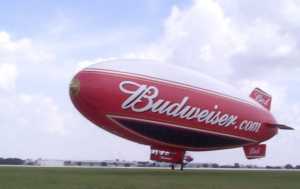 Like many things in life, getting a ride in an airship can be a matter of being in the right place at the right time. On Friday the 13th, your AVweb reporter was headed for Choppertown, camera in hand, when the Budweiser courtesy van stopped nearby to onload some passengers. Next thing you know, she's being marched across a grassy field with six other lucky folks to meet the Budweiser blimp as it touches down. Its dangling ground lines are caught by the sturdy crew, who dig in their heels to hold the beast steady. The two big fans never stop running, and once everyone's belted in, the driver points the nose into the wind and off we go. With a bit of a ground roll, two props turning and a climbing takeoff, it feels more like an overgrown airplane than like its lighter-than-air relatives, the free balloons.
Like many things in life, getting a ride in an airship can be a matter of being in the right place at the right time. On Friday the 13th, your AVweb reporter was headed for Choppertown, camera in hand, when the Budweiser courtesy van stopped nearby to onload some passengers. Next thing you know, she's being marched across a grassy field with six other lucky folks to meet the Budweiser blimp as it touches down. Its dangling ground lines are caught by the sturdy crew, who dig in their heels to hold the beast steady. The two big fans never stop running, and once everyone's belted in, the driver points the nose into the wind and off we go. With a bit of a ground roll, two props turning and a climbing takeoff, it feels more like an overgrown airplane than like its lighter-than-air relatives, the free balloons.
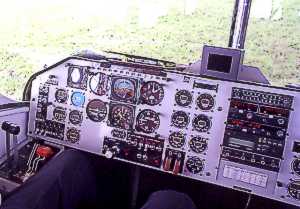 Our pilot, 27-year-old Matthew St. John, works hard to fly the blimp through the midday thermals, and it dips and rolls and sways a bit like a beamy old boat. With no hydraulics, just cable connections, it takes a bit of muscle to work the elevator trim and rudder controls. We wander up to about 1,000 feet - "We usually fly low for visibility, so people on the ground can read the logo," says Matt - and enjoy the view. The blimp's top speed is 52 knots, but we're "just hanging out in the sky," as Matt puts it, so we amble along at what seems about bicycle speed. He shows us a few maneuvers - a steep climb and descent, a "hover" when we just about stand still - then all too soon we head back to Linder Field. Matt checks in with Choppertown Tower, which tells him to watch for traffic. "I'll keep my eye out for them," he says. And the tower comes right back, "I guess they'll keep an eye out for you, won't they." True enough, the big red blimp would be tough to miss - and if you ever get a chance to fly in one, don't miss it.
Our pilot, 27-year-old Matthew St. John, works hard to fly the blimp through the midday thermals, and it dips and rolls and sways a bit like a beamy old boat. With no hydraulics, just cable connections, it takes a bit of muscle to work the elevator trim and rudder controls. We wander up to about 1,000 feet - "We usually fly low for visibility, so people on the ground can read the logo," says Matt - and enjoy the view. The blimp's top speed is 52 knots, but we're "just hanging out in the sky," as Matt puts it, so we amble along at what seems about bicycle speed. He shows us a few maneuvers - a steep climb and descent, a "hover" when we just about stand still - then all too soon we head back to Linder Field. Matt checks in with Choppertown Tower, which tells him to watch for traffic. "I'll keep my eye out for them," he says. And the tower comes right back, "I guess they'll keep an eye out for you, won't they." True enough, the big red blimp would be tough to miss - and if you ever get a chance to fly in one, don't miss it.
- Mary Grady
...Hanging On By A Dread
I used to think ultralights were a fad that would pass by in time, like the pet rock or Peter Frampton. But, as I attended more and more events like Sun 'n Fun, I grew more and more interested in them; how they flew, design and construction techniques, flight characteristics, etc. I never really thought about going up in one, content as I was to look, but not touch. That was pretty much the extent of my longing until last Thursday evening while lounging around the RV owned by Chuck Sluzarczyk, of CGS Aviation fame, over in Paradise City. For those unfortunate few who either haven't been to Sun 'n Fun or who have never made it to the ultralight display and staging area, Paradise City is where the powered parachutes, trikes and ultralights of every conceivable shape, color and design come out to play each morning and evening when the wind is calm.
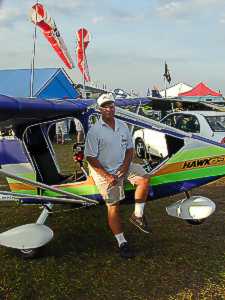 Chuck, one of the nicest, most outgoing guys you'll ever meet, soon discovered that I had never been aloft in an ultralight. Quicker than I could say, "Uhhh, I don't know about this," I was being ushered off to the flight line and stuffed into the front seat of one of Chuck's demonstrators, a two-seat CGS Hawk ably flown by Grant Smith. Once I strapped in and donned the headset (yes, this craft has an electrical system, including a starter), we cranked up and taxied into position. Before I knew it, some grinning flagman had waved us into position and Grant was urging me to shove the throttle forward to full power and pull back on the stick. It was at about this point that I realized there was no turning back, and did as I was told. A few seconds later, we were rolling along the grass runway at Paradise City and lifting off to the admiring gaze of the hundreds of onlookers gathered beside the runway.
Chuck, one of the nicest, most outgoing guys you'll ever meet, soon discovered that I had never been aloft in an ultralight. Quicker than I could say, "Uhhh, I don't know about this," I was being ushered off to the flight line and stuffed into the front seat of one of Chuck's demonstrators, a two-seat CGS Hawk ably flown by Grant Smith. Once I strapped in and donned the headset (yes, this craft has an electrical system, including a starter), we cranked up and taxied into position. Before I knew it, some grinning flagman had waved us into position and Grant was urging me to shove the throttle forward to full power and pull back on the stick. It was at about this point that I realized there was no turning back, and did as I was told. A few seconds later, we were rolling along the grass runway at Paradise City and lifting off to the admiring gaze of the hundreds of onlookers gathered beside the runway.
That's when it hit me: this isn't my Debonair. For one thing, it was a bit breezier than I'm used to (the zippered vinyl doors had been removed, but the Plexiglas windshield kept the bugs out of my teeth). For another, there was nothing to lean against and the only thing to hold onto - other than the control stick - was the fuselage tubing that sloped down to the nose on either side of me. The first few moments were very disorienting. Between the noise of the four-cylinder Hirth engine spinning its three-blade composite fixed-pitch prop a few scant feet behind me, the wind and the visual sensation combined to assault my senses like few other takeoffs I have ever made. That's when Grant suggested that I relax my grip on the tubing, lest I leave permanent indentations.
But that initial disorientation was momentary. By the time we had cleared the pattern and were preparing for some airwork, my head had cleared and I was ready to investigate this contraption. I was pleasantly surprised. For one thing, it flew like, well, an airplane. It has a control stick, rudder pedals, pitch trim; even wing flaps. Its instrumentation was basic, but not unlike what one would find in a J-3 Cub: an airspeed indicator registering in MPH, an altimeter and a vertical speed indicator. Elsewhere on the panel in front of me were a tachometer and engine gages.
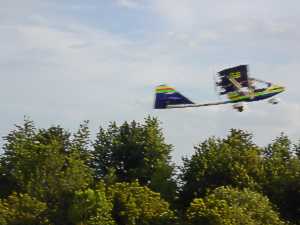 At Grant's urging, we did some turns - a mix of steep and shallow, but all gentle - then pulled the power off and the nose up to sample the Hawk's slow-flight characteristics. Brought down to a measly 38 MPH indicated, the Hawk complained little, eventually deciding to signal an imminent stall with a very gentle burble and no tendency whatsoever to either quit flying or drop a wing. Adding power and lowering the nose - just like in a "real" airplane - had us flying again and angling toward the grass strip at the South Lakeland Airport. As we joined the pattern, the wide-open view from the cockpit made it easy to pick out all the traffic, mainly other ultralights out doing the same thing we were. A notch of flaps here and there, a few gradual power reductions and we were rolling on the runway, feeding the Hirth throttle and lifting off the grass after a touch and go. Cleaning up the flaps at a safe altitude and setting cruise power, we aimed for the Paradise City strip and joined that pattern. Repeating the process learned in the pattern at South Lakeland we were soon on final and thumping down onto the grass, again. So ended my first - but not last - flight in an ultralight.
At Grant's urging, we did some turns - a mix of steep and shallow, but all gentle - then pulled the power off and the nose up to sample the Hawk's slow-flight characteristics. Brought down to a measly 38 MPH indicated, the Hawk complained little, eventually deciding to signal an imminent stall with a very gentle burble and no tendency whatsoever to either quit flying or drop a wing. Adding power and lowering the nose - just like in a "real" airplane - had us flying again and angling toward the grass strip at the South Lakeland Airport. As we joined the pattern, the wide-open view from the cockpit made it easy to pick out all the traffic, mainly other ultralights out doing the same thing we were. A notch of flaps here and there, a few gradual power reductions and we were rolling on the runway, feeding the Hirth throttle and lifting off the grass after a touch and go. Cleaning up the flaps at a safe altitude and setting cruise power, we aimed for the Paradise City strip and joined that pattern. Repeating the process learned in the pattern at South Lakeland we were soon on final and thumping down onto the grass, again. So ended my first - but not last - flight in an ultralight.
I came away from that 20-minute hop with a new appreciation for a side of aviation in which I had never before had the chance to participate. I also was impressed with Chuck's operation and his aircraft. All the familiar controls were there and they worked as expected. The view was incredible, making it a cinch to spot all the traffic around Sun 'n Fun. The Hawk is an easy aircraft to fly and - despite the significant differences between its control feel and that of my Debonair - should be easy to master for even the greenest pilot. It's just the thing for the casual pilot or for someone, like me, who can't conceive of taking his IFR-equipped, cross-country machine out for some low-and-slow flying on a calm summer afternoon.
Would I do it again? You bet. One of these days, I may even start looking for a place from which to fly one and investigate buying my very own.
Chuck and Grant: Many thanks.
- Joseph E. (Jeb) Burnside
New Piper Celebrates Cub's 70th, Plans For Its Own Future
Cutting The Cake...
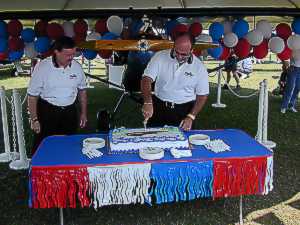 Sometimes things just work out better than they could have been planned. So it was with the 70th birthday celebration for Bill Piper's venerable, classic Cub. Seventy years earlier, the Piper Cub was born, and New Piper, the current keeper of the flame that is all things Piper, wasn't about to let anyone forget it this week during Sun 'n Fun. Last Monday, New Piper's Chuck Suma met with journalists to detail some of the company's history and share some thoughts about where he was aiming the company. Later, a brief ceremony at New Piper's exhibit tent featured a birthday cake served in front of the ninth Piper Cub to be made, which, not coincidentally, was born on April 9, 1931, 70 years ago to the day.
Sometimes things just work out better than they could have been planned. So it was with the 70th birthday celebration for Bill Piper's venerable, classic Cub. Seventy years earlier, the Piper Cub was born, and New Piper, the current keeper of the flame that is all things Piper, wasn't about to let anyone forget it this week during Sun 'n Fun. Last Monday, New Piper's Chuck Suma met with journalists to detail some of the company's history and share some thoughts about where he was aiming the company. Later, a brief ceremony at New Piper's exhibit tent featured a birthday cake served in front of the ninth Piper Cub to be made, which, not coincidentally, was born on April 9, 1931, 70 years ago to the day.
As Suma outlined, New Piper has come a long, long way from the dark days of 1991. Back then, the company's predecessor had been mired in bankruptcy and there were only 45 people employed, some spare parts, some fixtures and jigs, and a lot of dreams yet to be fulfilled. In 1995, New Piper was formed when Suma and colleagues acquired the defunct company's assets. Since then, New Piper has revived the production lines and the brand, introducing refined versions of the marque's traditional best-sellers and developing the turbine-powered Malibu Meridian. Indeed, Piper is the only company offering a twin-engine plane for flight schools - the Seminole - and one of the few still making what in this day and age passes for a full line of factory-built airplanes: From the Warrior III, to the Archer III, the Arrow and up into the various Saratoga and Malibu models and to the Seneca V turbocharged twin and the Meridian, New Piper tries to fill all the market niches.
...And A Five-year Plan
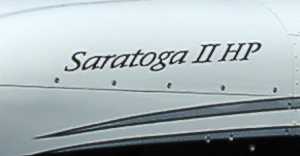 Now, more than five years after taking the yoke at New Piper, Suma is apparently finding some breathing room, so much so that he and his team are looking up the road at a variety of growth targets. Suma dubbed the company's ambitious intentions "Flight Plan 2005." For example, Suma says he intends to at least double New Piper's revenues by 2005, from the current $181 million each year to more than $500 million in the fifth year. Along with that growth will come additional employee development, including a attempt to develop New Piper's core business and make radical changes to improve the manufacturing process.
Now, more than five years after taking the yoke at New Piper, Suma is apparently finding some breathing room, so much so that he and his team are looking up the road at a variety of growth targets. Suma dubbed the company's ambitious intentions "Flight Plan 2005." For example, Suma says he intends to at least double New Piper's revenues by 2005, from the current $181 million each year to more than $500 million in the fifth year. Along with that growth will come additional employee development, including a attempt to develop New Piper's core business and make radical changes to improve the manufacturing process.
Another challenge Suma intends to meet is improving the company's image, to attract the attention of new entrants in the GA marketplace. This will entail some co-branding (Suma has already entered into a partnership with Exxon Mobil to promote the New Piper's products in ads for Exxon Mobil aviation lubricants) and working to ensure that current customers are constantly pleased with their ownership experience and that new customers - those who approach the GA marketplace without preconceptions - will come to know New Piper as a trustworthy company sharing their lifestyle goals. Finally, Suma plans to develop new aviation-related businesses, including service centers, FBOs, finishing and refurbishment centers and facilities designed for reconditioning older airframes. All this will occur over a two-to-three year timeframe as the new ideas are fully developed and rolled out.
Will any of these plans involve new aircraft or new powerplants? Smiling, Suma wouldn't go on-record, saying only that the next few years would be exciting ones at New Piper as the company builds on its deep, long-standing roots and looks to its future. Here's hoping that Suma can pull it off.
Another Excuse To Visit Sunny Florida: Air Races In November
 For Northerners who revel in the springtime climate at Sun 'n Fun, a new aviation event might just entice them to return in November, when the days at home are getting short and chilly again. For fans of the fast, the brand-new Homestead/Miami Air Races and Sport Aviation Competition will be staged November 17-18 at Homestead Regional Airport (a former Air Force base), about an hour south of Miami. The weekend event will focus on competition, and besides Formula One Air Racing around pylons, will feature contests among ultralight flyers, skydivers, radio-controlled model aircraft, and aerobatic pilots. Other attractions will include military demonstration flights, static displays, and FAA safety seminars. For more information, click on "Events" at the Miami-Dade Aviation Department web site.
For Northerners who revel in the springtime climate at Sun 'n Fun, a new aviation event might just entice them to return in November, when the days at home are getting short and chilly again. For fans of the fast, the brand-new Homestead/Miami Air Races and Sport Aviation Competition will be staged November 17-18 at Homestead Regional Airport (a former Air Force base), about an hour south of Miami. The weekend event will focus on competition, and besides Formula One Air Racing around pylons, will feature contests among ultralight flyers, skydivers, radio-controlled model aircraft, and aerobatic pilots. Other attractions will include military demonstration flights, static displays, and FAA safety seminars. For more information, click on "Events" at the Miami-Dade Aviation Department web site.
A Different Kind Of Hall Of Famer
If you've ever heard of the Moni motor glider, the Monerai or the Sonerai series or Sonex aircraft, you've heard of John Monnett and if you haven't, it's time you had - Monnett has been selected as a Nov. 2001 inductee to the EAA Homebuilders Hall of Fame. He has been active in experimental aviation for nearly 30 years and created some 14 original designs (most of them, light, all-metal, single or two place designs) in his tenure as an experimental aircraft designer. He was also instrumental in the popularization of the Volkswagen engine conversion for use in homebuilt aircraft. Those contributions have been *very* appreciated by a loyal band of followers who, if not for Monnett, may have been unable to afford the pleasure of flying aircraft with better than average performance that they could afford. Monnett's newest design, the Sonex flies behind a Jabiru 4-stroke engine and is another example his simple, affordable and practical design philosophy. Sonex first flew in February 1998 and the first builder completion was flown in June of 2000. Seven more builders have since completed their aircraft.
International Visitors Find Lots Of Friends
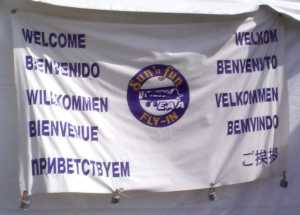 Flying fascinates people everywhere, not just in the U.S., so naturally an event like Sun 'n Fun attracts folks from all over the world. A visit to the International Visitors' Tent late in the week found that 2,085 travelers from 77 countries had signed in. Many seek help with our quirky language, and an intrepid band of volunteers stands ready to translate for speakers of German, Portuguese, Italian, Danish, Finnish, Russian, and more. One friendly volunteer, Sia, of Largo, Fla., a virtual Babel-of-one, speaks Greek, Arabic, or French on request. The largest contingent of visitors, though, is Canadian, with almost 400 signed up, most of them probably English-speakers. Next to our northern neighbor, Brazil and England sent the most sightseers, while only one traveler apiece got here all the way from Singapore, Kazakhstan, and Singapore.
Flying fascinates people everywhere, not just in the U.S., so naturally an event like Sun 'n Fun attracts folks from all over the world. A visit to the International Visitors' Tent late in the week found that 2,085 travelers from 77 countries had signed in. Many seek help with our quirky language, and an intrepid band of volunteers stands ready to translate for speakers of German, Portuguese, Italian, Danish, Finnish, Russian, and more. One friendly volunteer, Sia, of Largo, Fla., a virtual Babel-of-one, speaks Greek, Arabic, or French on request. The largest contingent of visitors, though, is Canadian, with almost 400 signed up, most of them probably English-speakers. Next to our northern neighbor, Brazil and England sent the most sightseers, while only one traveler apiece got here all the way from Singapore, Kazakhstan, and Singapore.



